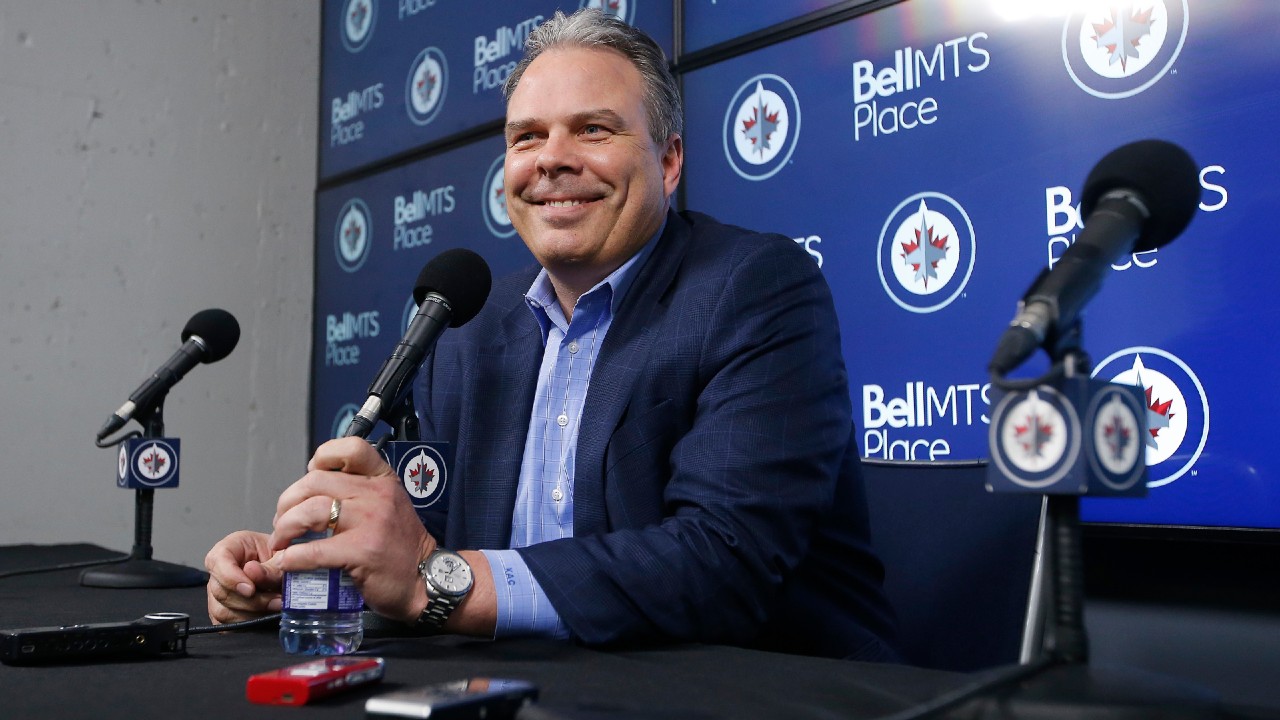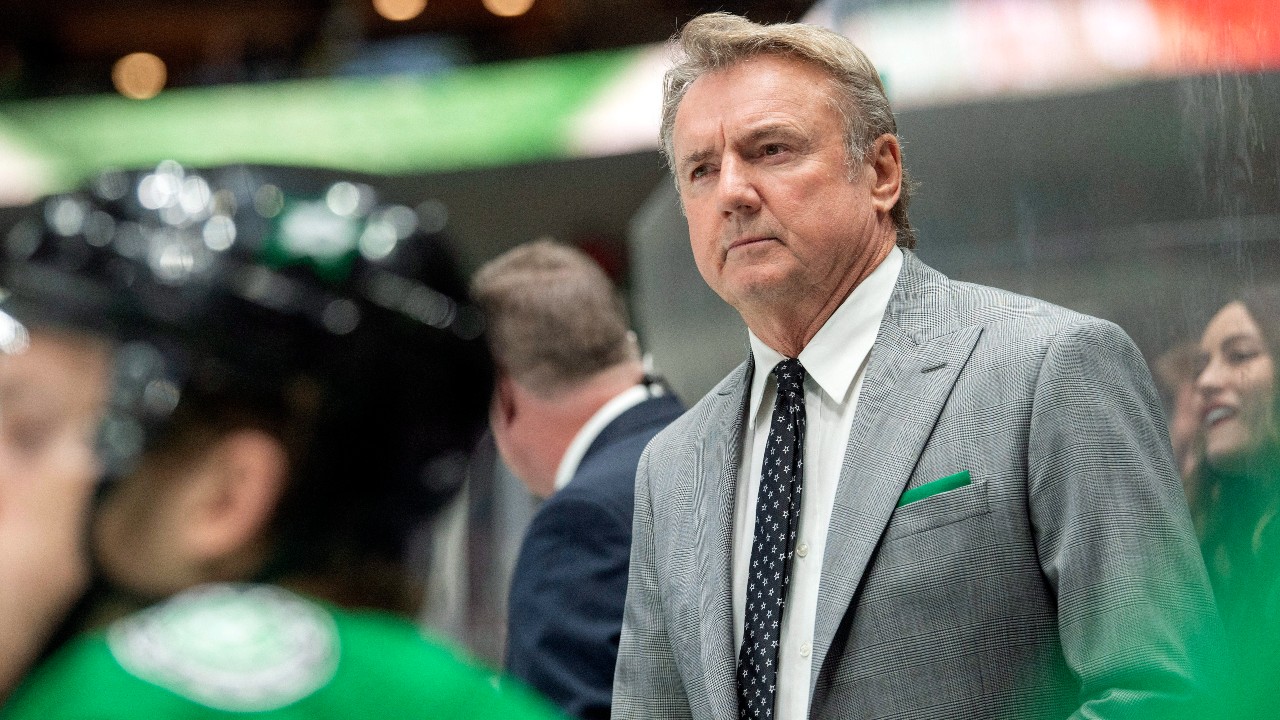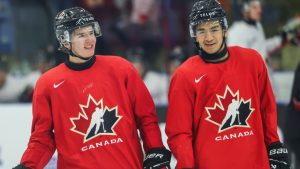WINNIPEG — The intrigue surrounding Pierre-Luc Dubois remains and the short-term future of the restricted free agent remains very much up in the air.
But for those who believe the situation has reached the point of no return or has only one possible outcome available, step away from the table and take a deep breath.
That’s not necessarily the case.
Monday’s 4 p.m. CT deadline for the Winnipeg Jets to trigger club-elected arbitration for the aforementioned resolution came and went without a filing.
Some might see that as an olive branch being extended by the Jets, who very much want Dubois to be part of the solution moving forward.
On the flip side, the Jets decision not to file for arbitration means the organization runs the risk of a contract not being signed until after training camp — or even as the regular season begins.
Before we get too far, no this is not a holdout if Dubois doesn’t report to training camp, since he does not have a deal at this point and would not be breaking any sort of commitment.
It also doesn’t mean that a one-year agreement can’t be reached well before training camp begins.
However, there is also a risk for Dubois if this drags on too long, especially when you consider how things ended for him as a member of the Columbus Blue Jackets.
There’s no chance Dubois sits out the year and chances are bordering on slim to none that he’d consider going overseas to the highest bidder as part of any plan to expedite the process of the Jets trading him to his preferred team of choice, his hometown Montreal Canadiens.
You don’t throw a season of your prime away at the age of 24, especially when your career high for goals is 28 (set last season) and your career high for points is 61 (set in 2018-19) and you’d eventually like to sign a long-term contract with an AAV north of $8 million — and possibly as high as $9 million.
Even if Dubois wants to end up in la Belle Province by 2024 or sooner, his best bet is to agree to terms on a one-year deal with the Jets (likely for between $6.5-to-7 million), play hard and put together his best season as a pro riding shotgun with sniper Kyle Connor.
Play with high engagement, boost your stock and show the Canadiens why you’re going to be worth the long-term investment and the package/prospect pool it’s going to take to acquire your services.
There are still plenty of twists and turns that could be on the horizon, but for the time being, Dubois is susceptible to an offer sheet — though it’s important to remember those are pretty rare and the Jets are in prime position to match almost any offer.
So we are left to wait to see which side blinks first - if anyone blinks at all.
Will the Canadiens come up with a better trade offer or just wait patiently until the summer of 2024, potentially running the risk of another team enticing Dubois by making a better offer?
Will the Jets grow impatient and look for clarity and perhaps even lower the asking price?
The staring contest continues and the situation remains at a standstill, at least for the time being.
What we know for sure is that there is pressure on Jets general manager Kevin Cheveldayoff to handle this delicate situation with extreme care.
Trading Patrik Laine, the second overall pick in the 2016 NHL Draft, always came with a high level of risk and signing Dubois to a long-term contract is the only outcome that was going to be acceptable for a segment of the fan base.
Even if you believe Dubois has at least one foot out the door, it’s important to see how things play out before jumping to conclusions.
At no point has Dubois said he’s unhappy with his current lot in life, nor has he suggested the fabled Habs are the only team he’s willing to play for next season or is interested in signing with long term, for that matter.
The future of Dubois was a popular topic in my inbox for the Jets July mailbag, so let’s get to your questions.
Did the Calgary Flames fan base experience half the “anxiety/panic” about Gaudreau two years ago that Jets fans are demonstrating about PLD two years in advance of UFA status? Can he play 1.5 years and the Jets deal him at the deadline in 2024 for a package much bigger than Andrew Copp’s? - Craig Zamzow
I don’t recall many Flames fans suggesting that Gaudreau be traded two years ago to maximize his trade value, nor do I recall hearing many/any of those people suggesting at the trade deadline that Gaudreau should be moved by the team that was leading the Pacific Division. The key difference being that Gaudreau was playing on a six-year, $40.5 million contract he signed with the Flames in 2016. I understand that having a superstar walk away for nothing does not satisfy many folks in the asset management crowd, but when a team is trying to win, keeping a player when an organization is “going for it” is part of the cost of doing business. When it works out, it can be easy to look back and suggest it could have been handled differently, no doubt about it.
As for the second part of the question, it seems increasingly unlikely that Dubois will play one-and-a-half seasons with the Jets, unless something changes dramatically. As for managing the asset, if the Jets were to consider moving Dubois, it would be more likely to come next offseason — or perhaps prior to the 2023 NHL trade deadline, since the acquiring team could conceivably have Dubois for two playoff runs — thus providing the potential to maximize the return, even if it seems inevitable that Dubois is going to end up in Montreal once he gets his first crack at unrestricted free agency. When it comes to the return, the package that Jets were able to extract from the New York Rangers for forward prospect Morgan Barron, a first-round pick (that became Brad Lambert) and a second-rounder (that become defenceman Elias Solomonsson, who signed his entry-level deal last week) was a solid return for a rental. Any team looking to trade for Dubois should be prepared to offer a similar (or better) package. Otherwise, they are likely to hear a dial tone at the end of the conversation.
In theory, do the Jets now need to trade Pierre-Luc Dubois, just because of how public everything has come out of his desire to play in Montreal. I can see him doing what he did in Columbus and stop trying until he gets what he wants. Bringing him back into that dressing room too, for whatever the locker room issues are for the Jets. Bringing Dubois back after all this might [not] help that either. What are your thoughts on the PLD situation? - Troy Morris
There are times when the application of public pressure can be used as a negotiating tactic and I don’t think for a second that agent Pat Brisson accidentally let it slip that his client eventually has an interest in suiting up for the Canadiens. You don’t become one of the most powerful agents in the business by accident and it’s clear that the Dubois camp isn’t afraid to apply pressure in certain situations (see Blue Jackets, Columbus). Given how Dubois went out of his way to say he would not be defined by “the shift”, it’s hard to imagine him risking his reputation by checking out or putting things on cruise control if he remains with the Jets next season. Remember, Dubois is looking for long-term security and he’s not about to achieve that goal by mailing it in. As for locker room issues, players understand this is a business and Dubois wouldn’t be the first guy who might have his eyes on his next suitor, nor will he be the last. Does that mean there are not any risks? Absolutely not. But Dubois showed plenty of accountability last season to go along with a high engagement level, so his standing within the dressing room is unlikely to be impacted by what has taken place so far. Ultimately, how he plays on the ice and how he interacts with the group are all that matter to his teammates. There’s a growing list of players who either asked to be moved publicly or privately over the years.
Kevin Cheveldayoff has seemingly signed a bunch of LHD to a contract despite already having a log jam in that position. It makes me think he’s moving one or two of the more established D and is trying to backfill the Moose when Ville Heinola and Dylan Samberg move to the big club. Any guesses on what move Cheveldayoff makes? - Cole Grove
During his meeting with members of the media on the opening day of free agency (before the Jets signed depth blue-liners Kyle Capobianco and Ashton Sautner), Cheveldayoff conceded that he was looking to upgrade the forward position and was comfortable in goal and on the blue line. While Cheveldayoff reiterated he’d rather have too many D-men than not enough, it’s clear a move (or two) are coming on the back end. One of the reasons Rick Bowness was hired was because of his ability to integrate young blue-liners into the group, so most signs point to Ville Heinola or Dylan Samberg being part of the regular rotation next season. Where does that leave the long line of veterans? It leaves at least one of them waiting patiently to be moved to another club. Experienced D-men are always in demand, now it’s about finding the right fit in a trade. While the Jets would prefer to keep Brenden Dillon in the fold, his two-year term with an AAV of $3.9 million figures to be a number several contenders would be willing (and able) to absorb. That doesn’t mean Dillon is automatically going to be the D-man on the move, it means that teams are probably asking about his availability. Since prospect Declan Chisholm showed well during his cameo with the Jets last season, the impetus to alleviate the logjam on the left side.
Do you think the Jets are more likely to trade veteran defencemen or up-and-coming defencemen for help up front? Or possibly even one of each? (For example: Nate Schmidt and Ville Heinola both traded for forwards). - Bjorn Bjornson
It’s impossible to know for sure what direction things are going to go when it comes to a trade because a D-man could be part of a larger package, perhaps one involving longtime captain Blake Wheeler. When it comes to the specific players you mentioned, a deal involving Schmidt is a complex one because his AAV comes in at just under $6 million ($5.95 to be precise) and it goes for three more seasons. And while it’s true that’s a big ticket for a guy who spent a good chunk of the season playing on the third pairing with Logan Stanley, Schmidt actually had a strong start to the campaign when he was playing alongside Josh Morrissey. Schmidt also had a solid showing for Team USA at the 2022 IIHF Men’s World Hockey Championship, so that’s something he’ll try to build on going into next season. As for Heinola, he’s poised to get his best opportunity to be an NHL regular and I don’t envision a scenario where he’s moved in a trade — unless it involves a high-end forward with multiple seasons of team control — and even then, I’m not certain that would be enough to entice the Jets to part ways with their top defence prospect.
What are your thoughts on no matter how the Jets do this year if they revisit Barry Trotz about coming on board for next year? Seems like Rick Bowness would be comfortable stepping into an associate role if that were to happen. - Jon Meseman
While it’s clear that Trotz, the pride of Dauphin, was the Jets’ top target in the coaching search, it’s unlikely this was just a temporary decision that was made. If that possibility were even under consideration, there’s no reason the Jets would have tacked an option year at the end of the two-year deal with Bowness. And while it’s true that Bowness has embraced being the second choice and went out of his way to say he’s never made a big deal of titles, he’s not dipping his toe into the water here with the expectation of stepping into the shadows next season, should Trotz reconsider his position. Bowness is all-in on the top job and the Jets are all-in on him. Both the individual and the organization are banking on this working, it isn’t a Band-Aid solution. Also, the Jets already have an associate coach in Scott Arniel who left a very comfortable situation with the Washington Capitals to join Bowness’ staff.
Connor Hellebuyck said he’d stick around if they were going for it. How does playing it back again with the same crew, while adding non-needle-movers like Kristian Reichel and David Gustavsson, satisfy the starting goalie? What in the world is the plan to fix the room and the mood of the players? - @ChuckHawerdale
The Jets can’t possibly run back the same roster, can they? Are they trying to be mediocre on purpose? - Matt Robinson
Let’s deal with this as a two for the price of one situation. It’s clear that signing backup goalie David Rittich to replace Eric Comrie and adding depth forward Kevin Stenlund to compete for a 12th or 13th forward role to go along with two D-men has not given members of Jets Nation much to get excited about when it comes to the 2022-23 roster. That’s understandable. Even if Cole Perfetti is ready to be a full-time contributor, the forward group has lost Copp and is likely to lose Paul Stastny, so improvements are required up front. Even if Cheveldayoff said publicly that he’s comfortable with running back the core, that doesn’t mean that he’s not trying to augment that group via trade or free agency. Ultimately, the proof will be in the pudding, but the expectation is that a significant move is still going to be made and it likely involves Wheeler. For the time being, the Jets seem set in not retaining salary in a trade with Wheeler but that’s not to say the stance won’t change over time. A team that has Wheeler on its respective radar is likely looking at all options when it comes to how much of the $8.25 AAV they can absorb. As for how Hellebuyck feels, only he knows for sure but the No. 1 goalie is rarely short on confidence in the group and he’s likely curious to see what else could happen before the season (which is still nearly three months away) begins. When it comes to frustration in the room, winning games is probably the most important ingredient to ensuring harmony.
Winnipeg clearly has a challenge attracting players to come and play. Does long term mediocrity seem inevitable? What does that mean for fans supporting this team? Should they be all in on analytics if they can’t afford to get decisions wrong? - Dave Zielinski
It’s fair to suggest the Jets are challenged to attract the high-profile free agents (and sometimes even the mid-range players) to the market, but they’ve had a fair amount of success convincing players who were either drafted by the organization or traded here to sign long-term. That doesn’t mean everyone is happy or that they all stay, but plenty of players made a commitment to the organization. Those commitments are easier to make when the franchise is enjoying success, no doubt about it. What’s your definition of mediocrity and did you feel the same way in 2019 when the Jets finished second overall in the NHL, three points behind the Nashville Predators in the chase for the Presidents’ Trophy? Or the following season when the Jets were being touted as legitimate contenders for the Stanley Cup before fading down the stretch and bowing out in the first round to the St. Louis Blues in 2019? There’s no doubt that the Jets have been spinning their respective wheels since the run to the Western Conference final and the gap between them and the Colorado Avalanche looks pretty wide right now. The Jets need to make a few moves to upgrade the personnel and they’re banking on a significant buy-in when it comes to the defensive commitment required to play the system that will be preached by Bowness and the coaching staff. As for analytics, the Jets have a department that they lean on and the numbers are an important part of the player evaluation process, but it’s a part of the equation, not the be all and end all.
How much interaction and direct contact would someone like Jets GM Kevin Cheveldayoff have with the players, especially with the UFA and RFA players? Sounded like with Statsny he had just extended an offer to his agent and he will do what he will do. I would think a GM would be in personal discussions with guys trying to convince them that we were the best landing spot. Any insight around this subject would be appreciated. - Vic Loewen
This could vary somewhat depending on the organization, but the majority of negotiations take place between the GM (and/or the assistant GM) and the agent. Some players are more involved in the negotiation process than others, but the agent handles most — if not all — of the heavy lifting. That’s why players have agents. Sure, there are situations where a player looking for a change in scenery would possibly want to get on a call with a GM, but the player would express most of his concerns or questions to the agent and it’s up to the agent to get the answers. Having said that, Rittich (who was an unrestricted free agent) did mention a conversation he had with Jets goalie coach Wade Flaherty before agreeing to terms with the organization on July 13. As for Stastny, he would know exactly where he stands with the organization and what opportunities would be available to him based on his exit interview and what has transpired so far in free agency. Stastny knows he’s valued because Cheveldayoff didn’t entertain calls from teams prior to the NHL trade deadline, so it’s not like he would need assurances before making his decision as an unrestricted free agent. Stastny told reporters he would take his time before inking his next deal, so it’s not a big surprise that he hasn’t signed on the dotted line just yet.






